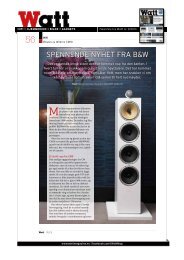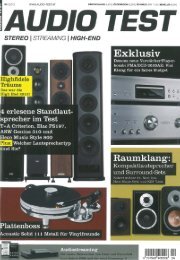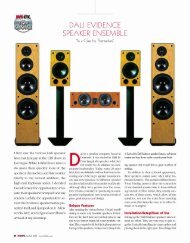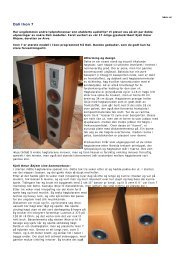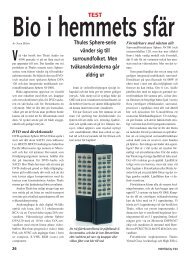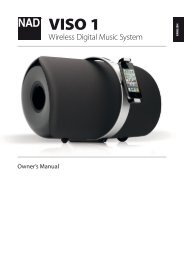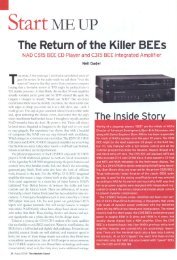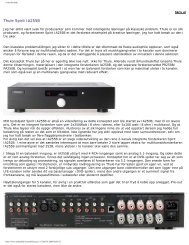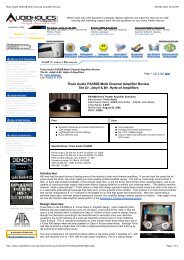Review : : . L73 DVD Receiver - Hi-Fi Klubben
Review : : . L73 DVD Receiver - Hi-Fi Klubben
Review : : . L73 DVD Receiver - Hi-Fi Klubben
You also want an ePaper? Increase the reach of your titles
YUMPU automatically turns print PDFs into web optimized ePapers that Google loves.
<strong>Review</strong> : : . <strong>L73</strong> <strong>DVD</strong> <strong>Receiver</strong><br />
soundstage.com<br />
Dec 2005<br />
<strong>Review</strong>er: Jeff Fritz<br />
"It sounded clear, spatially accurate, and had incredibly clean bass."<br />
The <strong>L73</strong> is awarded an editors' choice award as well as winning the 2005 Sound<br />
Stage Budget leader award.<br />
"Most explanations concerning the integrated amplifier extol the component’s<br />
simplistic design. There’s less cabling than for a preamp-power amp<br />
combination, one chassis for the manufacturer to sink the budget into (instead of<br />
multiple boxes), and no potential amp-to-preamp matching issues. There are<br />
some fine integrateds -- both of the two-channel variety as well as five-channel<br />
models -- on the market today.<br />
Entry-level separates, on the other hand, are touted because they have obvious<br />
advantages: greater chassis space, which usually means bigger, more-wellregulated<br />
power supplies; less constraint on component layout because things<br />
aren’t so crowded; greater physical shielding from section to section (i.e.,<br />
separation between analog, digital, and video circuitry).<br />
So should you buy separates or an integrated component? Either has the<br />
potential to be good, maybe even great. But what’s best? Perhaps the better<br />
question is, What’s best for your situation and your budget? The NAD <strong>L73</strong> <strong>DVD</strong><br />
receiver is an all-in-one component combining a <strong>DVD</strong> player, a multichannel
amplifier, a home-theater processor, and an AM/FM tuner. It costs $999 USD.<br />
Think of it as a home-theater-in-a-box without the speakers.<br />
What you get for your thousand dollars<br />
<strong>Fi</strong>rst off, you get 45 watts into five channels, and because the <strong>L73</strong> is from NAD,<br />
you can be pretty confident that the watts are real watts. When all channels are<br />
playing at the same time into real loudspeakers, there are at least 45 watts at<br />
your disposal. The stars don’t have to be aligned in a particular order for the <strong>L73</strong><br />
to produce its rated power. Believe me when I tell you that NAD’s specifications<br />
are something the company holds in high regard -- a stance that should be a<br />
given with electronics makers, but often isn’t. Knowing the real-world power<br />
output at your disposal gives this product points in my book. Although rated<br />
modestly -- but based on my use with some admittedly large speakers -- there’s<br />
a good likelihood that the <strong>L73</strong> is actually more powerful than many of the fullsized<br />
home-theater receivers on the market today.<br />
The <strong>L73</strong> is the best-looking of all the NAD products I’ve encountered (OK,<br />
excepting those in NAD’s brand-new Masters series, which are big bucks<br />
compared to the <strong>L73</strong> and which I haven’t used -- yet!). Its titanium color is a step<br />
up from the blue-gray of the company’s other products. The oblong buttons,<br />
readout window, and disc tray give the <strong>L73</strong> a distinctive look without being<br />
flashy or busy. Although not comparable in heft to any of the super receivers<br />
populating the market today, the <strong>L73</strong> is substantial at 26 pounds, though its<br />
modest dimensions (17 1/8"W x 5 1/4"H x 14 3/4"D) allow it to be placed on<br />
almost any small to moderately sized shelf or TV stand.<br />
Processing options are basic but acceptable, fitting most systems in which the<br />
<strong>L73</strong> is likely to be used. You get decoding for DTS 5.1 and Dolby Digital 5.1,<br />
which in my book is all that most folks need for <strong>DVD</strong>-Video. If you want 6.1-<br />
channel sound you need to look at more complex solutions than the <strong>L73</strong>,<br />
because, well, you’ll have a more complex system that requires more<br />
processing power, more amplification, and more money. But honestly, with a<br />
system budget under $2000, buying five good speakers to pair with the <strong>L73</strong> is a<br />
better option than splitting that same budget for six or seven speakers. Quality<br />
first, quantity last.<br />
Other processing options, which are designed to address your older twochannel<br />
movies and CD collection, include Dolby Pro Logic II and NAD’s<br />
proprietary EARS mode. These are both excellent options for turning stereo<br />
software into multichannel sound. EARS, in particular, can give you a rather<br />
subtle nudge into multichannel, as opposed to knocking you over the head with<br />
swirling effects. If you like the subdued effect of tasteful surround, you might<br />
enjoy listening to your CD collection with EARS, especially the recordings of live<br />
performances where natural ambience is present on the disc. EARS will draw<br />
that out and present it with finesse and class.<br />
Next up is the progressive-scan <strong>DVD</strong> player with component-video outputs, S-<br />
video outputs, and composite outputs. All of the functions present on mid-priced<br />
<strong>DVD</strong> players are present on the <strong>L73</strong>. Again, the very cutting edge of video --<br />
HDMI outputs, for instance -- are absent, but for most folks that won’t matter.<br />
One convenient aspect of the <strong>L73</strong> is that the myriad functions are controlled with<br />
one handy remote control. That alone will seal the deal for some people. The<br />
<strong>L73</strong> is about simplicity while not sacrificing the few complications that you<br />
absolutely must have. I’ve recommended the <strong>L73</strong> to buyers like my in-laws<br />
precisely because I know they can operate it from the get-go. An AM/FM RDS<br />
tuner with plenty of presets is included, too.<br />
Using the <strong>L73</strong><br />
The performance of this little NAD <strong>DVD</strong> receiver met my admittedly lofty
expectations. I watched quite a few <strong>DVD</strong>-Video movies and a number of<br />
concerts over the <strong>L73</strong>, and I can honestly say that I wasn’t disappointed once.<br />
The video, as shown over my Sharp Aquos flat-panel LCD monitor, was<br />
displayed with properly saturated colors and crisp, clear images. I watched the<br />
entire first season of Lost on the <strong>L73</strong>, and it was always impressive. Scenes<br />
displaying the ocean’s varying depths were replete with detail, while the dark<br />
green of the jungle’s trees and brush were rendered with effective contrast and<br />
good color accuracy. The freckles on the face of Kate (Evangeline Lilly) -- the<br />
cute-as-a-button-but-able-to-whup-the-men star of the show -- were lifelike in<br />
their presentation as well. Motion could cause the <strong>L73</strong> some problems, creating<br />
artifacts that I didn’t see over my Esoteric DV-50 universal audio/video player<br />
($5500), but that’s also true of most <strong>DVD</strong> players I’ve used -- some costing<br />
multiples of the <strong>L73</strong>’s price. Overall I was quite pleased with the video image.<br />
I remember borrowing an inexpensive Sony receiver from a friend when I moved<br />
into my home a few years ago. I needed to have some tunes and had not<br />
unpacked my heavy-duty gear. Expecting it to sound at least passable, I was<br />
shocked at what I heard. The sound, I recall, reminded me of that from a boombox<br />
with a wet blanket placed over it: heavy, slow, thick, and muffled. It was<br />
unbelievably bad. I listened to another entry-level receiver just recently, this time<br />
a Pioneer model that's also around $300. It was better than the Sony, but still<br />
pretty poor overall. The sound of the Pioneer was bleached and thin. The bass<br />
that was present was muddy and indistinct. That model was rated by the<br />
manufacturer to deliver 100 watts to five channels.<br />
Imagine my delight when I heard the <strong>L73</strong> for the first time. It made my Paradigm<br />
Reference Studio 100 v.3 speakers -- all five of them -- sound big and dynamic;<br />
in other words, it let the inherent quality of the speakers come through. Although<br />
I enjoyed a number of 5.1-channel discs through the <strong>L73</strong> I also listened to my<br />
fair share of good old CDs using the <strong>L73</strong>’s EARS processing. Probably my<br />
favorite example was Eva Cassidy’s Live at Blues Alley [Blix Street GS-10046].<br />
The ambient sounds in the recording are much more realistically portrayed by<br />
surround sound than with simple stereo. Sounds coming from the rear of the<br />
room made the soundstage expand three-dimensionally. The processing was<br />
not intrusive -- in fact, its strength was its subtlety with tracks such as "Tall<br />
Trees in Georgia" and "<strong>Fi</strong>elds of Gold." The result was that one of my favorite<br />
recordings became even more enjoyable because it was converted to tasteful<br />
surround sound.<br />
Sarah McLachlan’s Afterglow Live on <strong>DVD</strong>-Video is a fine illustration of why<br />
multichannel sound, when enhanced by clean video, is more common on the<br />
store shelves than SACD and <strong>DVD</strong>-Audio. This live concert is presented so that<br />
the viewer gets truly immersed in the experience -- the experience of seeing and<br />
hearing the show as it unfolded. Frankly, this is what the (hopefully) coming HD-<br />
<strong>DVD</strong> and Blu-ray formats can expand upon: excellent video coupled with crisp<br />
multichannel sound. The result? The NAD <strong>L73</strong> was completely enthralling due<br />
to the heartfelt manner in which the artist presented her life’s work. There was<br />
no hint of compromise in the sound that said "mini component" or "all-in-one<br />
system." The sound was big-rig dynamic. Instruments were delineated nicely,<br />
and the vocals were clear and present. Ambient sounds washed over my living<br />
room without washing out the nuances of the recording.<br />
The midrange clarity that I heard over the McLachlan <strong>DVD</strong> was also prominent<br />
with CDs I listened to in stereo. Johnny Cash’s American IV: The Man Comes<br />
Around [American 440 077 083-0] presents the Man in Black in his last days,<br />
and his voice is showing the signs of his many years of hard work. Nonetheless,<br />
his strength and conviction are obvious on my favorite track, "The Man Comes<br />
Around." This is a case where the singer’s emotions are contained within the<br />
texture of his voice. The <strong>L73</strong> did not mask this quality at all, making the track<br />
effective and emotional.
Discrete high-resolution surround, as fed through the <strong>L73</strong>'s 5.1-channel inputs<br />
via a Samsung <strong>DVD</strong>-HD841 universal audio/video player, crossed the threshold<br />
into audiophile-approved performance. Stowkowski's transcription of<br />
Mussorgsky's Pictures at an Exhibition on 5.0-channel SACD [Naxos 6.110101]<br />
was presented in all its grandeur. It sounded clear, spatially accurate, and had<br />
incredibly clean bass.<br />
Who might buy it? A lot of people, that’s who.<br />
The NAD <strong>L73</strong> is a highly-recommendable component. Maybe it’s not an easy<br />
sell for the rabid SoundStage!-reading stereo enthusiast, but it is a sure-fire bet<br />
for average folks looking for a terrific product in one easy-to-manage, attractive<br />
package. My in-laws are a perfect example. They appreciate good video and<br />
good sound but are not into equipment upgrading and auditioning components.<br />
(They would say that’s what I’m for, and it’s a role I gladly accept.) The <strong>L73</strong><br />
makes my job simple. It will work beautifully with their Samsung LCD TV, it will<br />
fit on a small shelf without drawing attention to itself, and its illuminated learning<br />
remote can provide control over the whole system. If NAD’s reputation is<br />
anything to go by, the <strong>L73</strong> should last them for years and be trouble-free.<br />
Am I making too much of the convenience factor? Not when you consider the<br />
fantastic performance that, in this case, comes with it. Consider this: Making an<br />
established product (the TV) flat created an entire market segment. Form<br />
matters. Although the NAD <strong>L73</strong> isn’t likely to start a revolution, it will appeal to a<br />
wide-ranging audience. I’m one of them, and I know there are a whole lot more<br />
people out there who will agree."



